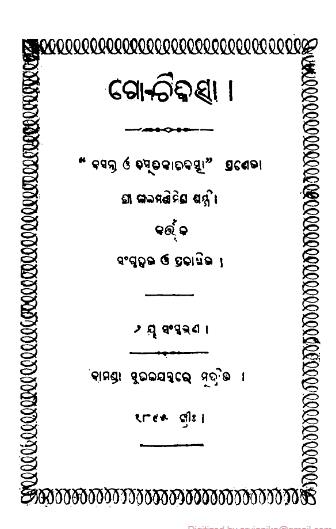Among the notable contributions to Odia literature and knowledge in the late 19th century, Go Chikitsa translated as Cattle Care, authored by the esteemed scholar Nilamani Bidyaratna and published in 1895, stands out as a remarkable work. This book is not just a guide to veterinary science but also an enlightening exploration of animal husbandry, agricultural practices, and the cultural significance of cattle in Odisha. In an era when the majority of the population engaged in agriculture, Bidyaratna’s insights into cattle care were invaluable, reflecting a deep understanding of rural life and its challenges.
At its core, Go Chikitsa serves as a comprehensive resource on the care and management of cattle, focusing on their health, nutrition, and well-being. Bidyaratna meticulously catalogs various diseases affecting cattle, providing detailed descriptions of symptoms and effective treatment methods. This practical information was especially critical for farmers, who depended heavily on cattle for their livelihoods. By equipping them with knowledge about the ailments their animals could face and how to care for them, Bidyaratna empowered rural communities to enhance their agricultural productivity and animal welfare.
One significant aspect of Go Chikitsa is its reflection of the cultural and economic importance of cattle in Odia society. In Odisha, cattle have traditionally held a central role in agricultural practices, not only as beasts of burden but also as sources of milk, fertilizer, and companionship. Through this work, Bidyaratna highlights how integral cattle are to the agrarian economy, emphasizing that proper care and management directly contribute to the prosperity of farming communities. His focus on cattle also underscores the broader connection between animal health, agricultural success, and community well-being.
Bidyaratna’s approach in Go Chikitsa is noteworthy for its blend of traditional knowledge and practical advice. He draws on ancient practices and local wisdom, incorporating Ayurvedic principles and folk treatments into his recommendations. This fusion of traditional medicine with emerging veterinary practices presents a holistic view of animal care, showcasing how indigenous knowledge systems can be vital in addressing contemporary challenges. By valuing local practices, Bidyaratna reinforces the importance of cultural heritage in the context of scientific advancement.
Additionally, Go Chikitsa serves an educational purpose, making veterinary knowledge accessible to a broader audience, including farmers who may have had limited formal education. By using clear language and relatable examples, Bidyaratna demystifies complex medical concepts, ensuring that his readers can easily apply the information in their daily lives. This accessibility is crucial in fostering a sense of responsibility and care towards animals among the farming community.
The publication of Go Chikitsa in 1895 came at a time when India was witnessing a burgeoning interest in scientific inquiry and modern education. Bidyaratna was part of a larger movement that aimed to uplift rural populations through education and awareness. His work aligns with the nationalist sentiments of the period, promoting self-sufficiency and resilience within rural communities. By focusing on animal husbandry, he not only addressed immediate agricultural needs but also encouraged a deeper respect for nature and its resources.
Books Info
| Books name | Go Chikitsa / ଗୋ ଚିକିତ୍ସା |
| Author | Nilamani Bidyaratna |
| No Of pages | 13 |
| Publisher | NA |
| Publication | 1895 |
| Printed At | NA |
| Distributor | NA |

